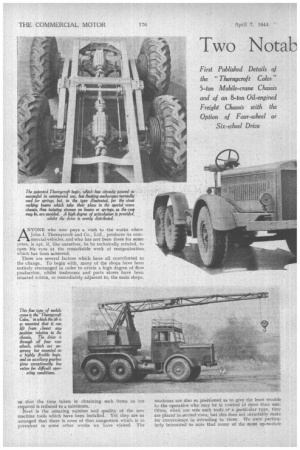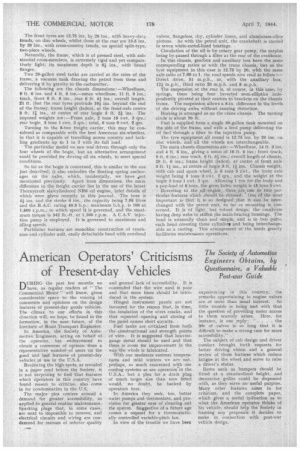Two Notab ■ Tew Models by Thornycroft
Page 26

Page 27

Page 28

If you've noticed an error in this article please click here to report it so we can fix it.
First Published Details of the " Thornycroft Coles" 5-ton Mobile-crane Chassis and of an 8-ton Oil-engined Freight Chassis with the Option of Four-wheel or Six-wheel Drive
ANYONE who now pays a visit to the works where John I. Thornycroft and Co., Ltd., produces its commercial vehicles, and who has not been there for some years, is apt, if, like ourselves, he be technically minded, to open his eyes at the remarkable work of reorganization, which has been achieved.
There are several factors which have all contributed to the change. To begin with, many of the shops have been entirely rearranged in order to attain a high degree of flow. production, whilst toolrooms and parts stores have been situated within, or immediately adjacent to, the main shops, so that the time taken in obtaining such items as are required is reduced to a minimum.
Next is the amazing number and quality of the new machine tools which have been installed. Yet they are so arranged that there is none at that congestion which is so prevalent in some other works we have visited. The machines are also so positioned as to give the least trouble to the operative who may be in control of more than one. Often, when one sees such tools of a particular type, they are placed in serried'rows, but this does not invariably make for convenience in attending to them: We were particularly interested to note that many of the most Up-to-date
tools, although bearing American names, carried plates indicating that they were manufactured in Britain—and that, in some instances, by concerns in the motor industry, Accuracy and speed in manufacture depend, to a large extent, not only upon the skill of the operatives, but Upon the quality and precision of the jigs and gauges employed, anthit is obvious that, at the Thornycroft works, the utrridst
attention is being given to this highly: important matter. :Another pointrwhich•will probably attract the :observer is the-large proportion of woman labour and•the excellent work which beth girls and older women arc performing. Some are already highly skilled and constitute a challenge to the men, both in quality and rate of production; but many of the machines are so arranged and equipped that even those workers of less ability can finish to close limits.
Our object, however, in visiting the works was not only to see how things were 'being done but also to examine some of the latest vehicles, and of these two in particular certainly proved of considerable interest. They were a. shortwheelbase, six-wheeled, 5-ton, mobile-crane chassis, Which, when complete, is known as the " Thornycroft Coles," and a sixWheeled freight carrier for a load of 8 tons.
The former can partly lift the biggest bomber and haul it across open country. The petrol power unit is the AC6/2, with a bore of 41 ins, and a stroke of 51 ins., the capacity being 7.759 litres and the A.A.0 rating 45.9 h.p., whilst• the output is 58 b.h.p. at 1,000 r.p.ra. and 100 ia.h.pi maximum. The torque at 1,000 r.p.m.• is 305 lb.-ft, Monobloc construction of the Cylinders promotes rigidity. There are renewable, dry, cylinder liners, detachable head, aluminium-alloy pistons, and overhead Valves for inlet and exhaust operated by push-rods with adjustable rockers: The crankshaft iS most carefully: balanced dynamically and statistically; in addition, it is mounted in seven white-metallined hearings of large diameter.
. A rotary gear pump delivers Oil to thehrhain and!con.
necting-rod bearings, also to the -camshaft and overheadvalve gear. The oil capacity of the sump is 21 gallons. Ignition is by h.t, magneto, with automatic advance, or,
alternatively, by distributor and coil.
An easy-starting device is embodied in the carburetter, whilst the induction system has a hot spot.
A centrifugal putup attends to the circulation of the cooling water, and the tension of the fan belt is adjUstable.
The simple type of vertical tubular radiator is flexibly mounted and equipped with thermometer and thermostat.
A smooth-acting, single-plate, dry clutch takes the drive • to a gearbox which forms a unit with the engine. It pro. vides four speeds forward and a reverse, with the lever at the left of the driver and mounted direct on the box, the oil level being indicated by an accessible maximum-level plug.
Bolted to the rear face of the' main gearbox; ana operated by a separate lever, is an auxiliary box, which provides a further reduction of 2.5 to 1, thus giving an additional range of exceptibrially low gear ratios for extremely bad conditions of operation.
The overall ratios and approximate speeds with the engine governed to 1,800 r.p.m., and a 7.66-to-1 axle ratio, are Main gearbox, fourth 7.65, 30 m.p.h.; third, 11.95, 13 m.p.h.; second, 21.06, 11 mph.; first, 39.3, 6 m.p.h.; reverse, 58.9, 4 m.p.h. With the auxiliary gearbox in aCtion, the corresponding figures are: —19.15, 12 m.p.h.; 29.87, 7,5 m.p.h.; 52.65, 4.5 m.p.h.; 98.25, 2.3 m.p.h.; 147.25, 1.5 m.p.h.
An open, tubular propeller shaft with two universal couplings connect§ with the worm-gear final drive. Both the worm shaft and differential are mounted on ball bearings, and the .road wheels on taper-roller bearings. The drive is, of course, tdken to all four wheels at the rear, which form part of the special Thornycrolt bogie, comprising four rigid beams in place of springs, independently pivoted at their centres to brackets attached to the chassis frame. It provides even distribution of weight on the wheels under all conditions up to the limit of articulation, and irrespective of the ielative movement of the axles, so that each wheel obtains equal driving torque, whilst the toirpie. reaction is transmitted directly to the frame through the beams. A difference of 71 ins, in driving-axle leVels is permitted without distortion, excessive movement being contralled by upper and lower buffers.
Triple vacuum-servo cylinder§ operate the brakes on all six wheels, there being one pair of shoes in each drum, with facings 3 ins. wide; the diameter of the drums is 17 ins, at the front and 20 ins, at the rear, and they can be removed -without disturbing the hub hearings. The hand brake controls. the Same shoes in •the rear drums only, through an independent means. The I-section front axle has kingpins carried in taperroller bearings and the steering is of the cam and roller type, the turning circle being about 56 it. To prevent undue deflection on the road when operating the crane, there are no rear springs, thus the stability is greatly inereaised, but the use of very large tyres, in conjunction with the unusual articulation of the bogie, permits driving across quite rough country The front tyres are 12.75 ins, by 20 ins., with heavy-duty treads, on disc wheels, whilst those at the rear are 13.5 ins. by 20 ins., with cross-country treads, on special split-type, two-piece wheels.
Naturally, the frame, which is of pressed steel, with substantial cross-members, is extremely rigid and yet comparatively light; its maximum depth is Sf ins., with broad flanges.
Two 20-gallon steel tanks are carried at' the sides of the frame, a vacuum tank drawing the petrol from these and
delivering it by gravity to the carburetter., The following are the chassis dimensions:—Wheelbase, 9 ft. 6 ins. and 4 ft. 6 ins.—mean wheelbase, 11 ft. 9 ins.; track, front 6 ft. 6 ins., rear 6 ft. 4i ins.; overall length, 21 ft. (but the rear tyres protrude 10i ins, beyond the end of the frame); frame height (laden), at the front-axle centre 3 ft. 1k ins., at centre of rear bogie 3 ft. 2f, ins. The imposed weights are :'—Front axle, 2 tons 18 cwt. 3 qrs.; rear bogie, 3 tons 1 cwt. 3 qrs.; total, 6 tons 0 cwt. 2 qrs,
Turning to the 8-ton freight carrier, this may be considered as comparable with the best American six-wheelers, in that it is capable of travelling across country and tack-. hug gradients up fo 1 in 3 with its full load.
The particular model we saw was driven through only the four wheels of the bogie, but an alternative arrangement could be provided for driving all six wheels, to meet special conditions.
So far as the bogie is concerned, this is similar to the one just described; it also embodies the floating spring anchorages on the axles, which, incidentally, we have jot mentioned previously. Apart from dimensions, the main difference hi the freight carrier lies in the use of the latest Thornycroft six-cylinderecl NR6 oil engine, brief details of which were given recently in this journal. The bore is 44 ins, and the stroke 6 ins., the capacity being 7.88 litres and the R.A.C. rating 40,8 h.p.; maximum b.h.p. is 100 at 1,800 r,p.m., to which speed it is governed, and the maximum torque is 392 lb-ft. at" 1,100 r.p.m. A C.A.V. injection pump is employed. It is governed to maximum and idling speeds.
Particular features are monobloc construction of crankcase and cylinder unit, easily detachable head with overhead valves, flangeless, dry, cylinder liners, and aluminium-alloy pistons. As with the petrol unit, the crankshaft is carried in seven white-metal-lined bearings.
Circulation of the oil is by rotary gear pump, the surplus being by-passed through a filter at the rear of the crankcase.
In this chassis, gearbox and auxiliary box have the same corresponding ratios as with the crane chassis, but as the tyre equipment in. this case is 12.75. by 20, with the same axle ratio of 7.68 to 1, the road speeds now read as follow :.Direct drive, 31 m.p.h., or, with the auxiliary box, 12i m.p.h., third ratio 20 m.p.h. and 8 m.p.h.
The suspension at the rear is, of course, in this case, by springs, there being four irivertad semi-elliptics independently pivoted at their centres to brackets on the chassis frame. The suspension allows a 6-in, difference In the levels of the driving axles without causing distortion.
Braking is arranged as on the crane chassis. • The turning circle is about 70 ft: Fuel is supplied from a single 30-gallon tank mounted on the side of the frame, and with a feed pump delivering the oil fuel through a filter to the injection pump.
The tyre equipment all round is 12.75 ins. by 20 ins'. on, disc wheels, and all the wheels are interchangeable.
The main chassis dimensions are :—Wheelbase, 14 ft. '3 ins. and 4 ft, 6 ins., giving a mean of 16 ft. 6 ins.; front track, 6 ft. 6 ins.; rear track, 6 ft, 51 ins.; overall length of chassis, 29 ft. 6 ins.; frame height (laden), at centre of front axle 3 ft. If ins., at centre of bogie ft. If ins. Chassis weight, with cab and spare wheel, is 6 tons 5 cwt., the front axle weight being 3 tons .3 cwt. 2 qrs., and the weight at the bogie 3 tons 1 cwt. 2 qrs. Allowing 1 ton for the body and a pay-load of 8 tons, the gross laden weight is 15 tons .5 cwt,
Reverting to the .oll• engine, there, are one or two particular features whiCh should be stressed: One of the most important issthat it_is so designed that it can be interchanged with the petrol unit, so far as mounting is concerned. It is of light, but tobust design, the crankcase having deep webs to stiffen the main-bearing housings. The head is unusually clean and simple, and is lu two parts, each head covering three cylinders and being interchangeable as 'a casting. This arrangement of the heads greatly facilitates maintenance operations.




















































